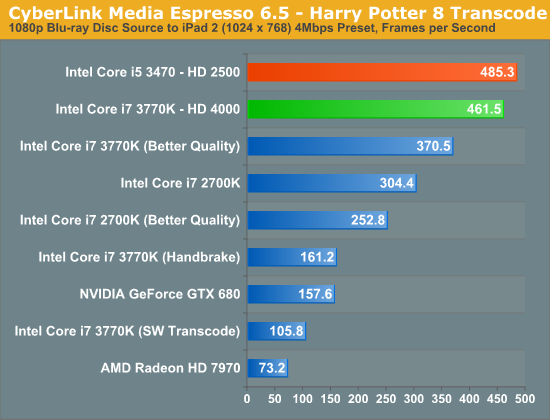Intel Core i5 3470 Review: HD 2500 Graphics Tested
by Anand Lal Shimpi on May 31, 2012 12:00 AM EST- Posted in
- CPUs
- Intel
- Ivy Bridge
- GPUs
Intel's HD 2500 & Quick Sync Performance
What makes the 3470 particularly interesting to look at is the fact that it features Intel's HD 2500 processor graphics. The main difference between the 2500 and 4000 is the number of compute units on-die:
| Intel Processor Graphics Comparison | ||||
| Intel HD 2500 | Intel HD 4000 | |||
| EUs | 6 | 16 | ||
| Base Clock | 650MHz | 650MHz | ||
| Max Turbo | 1150MHz | 1150MHz | ||
At 6 EUs, Intel's HD 2500 has the same number of compute resources as the previous generation HD 2000. In fact, Intel claims that performance should be around 10 - 20% faster than HD 2000 in 3D games. Given that Intel's HD 4000 is getting close to the minimum level of 3D performance we'd like to see from Intel, chances are the 2500 will not impress. We'll get to quantifying that shortly, but the good news is Quick Sync performance is retained:

The HD 2500 does a little better than our HD 4000 here, but that's just normal run to run variance. Quick Sync does rely heavily on the EU array for transcode work, but it looks like the workload itself isn't heavy enough to distinguish between the 6 EU HD 2500 and the 16 EU HD 4000. If your only need for Intel's processor graphics is for transcode work, the HD 2500 appears indistinguishable from the HD 4000.
The bad news is I can't say the same about its 3D graphics performance.










67 Comments
View All Comments
etamin - Thursday, May 31, 2012 - link
I just glossed through the charts (will read article tomorrow), but I noticed there are no Nehalems in the comparisons. It would be nice if both a Bloomfield and a Gulftown were thrown in. If Phenom IIs are still there, Nehalem shouldn't be THAT outdated right? Anyways, I'm sure the article is great. Thanks for your hard work and I look forward to reading this at work tomorrow :)SK8TRBOI - Thursday, May 31, 2012 - link
I agree with etamin - if Phenom is in there, a great Intel benchmark cpu would be the Nehalem i7-920 D0 OC'd to 3.6Ghz - I'd wager a significant percentage of Anand's readers (myself included!) still have this technological wonder in our everyday rigs. The i7-920 would be a good 'reference' for us all when evaluating/comparing performance.Thanks, and awesome article, as always!
CeriseCogburn - Thursday, May 31, 2012 - link
It's always "best" here to forget about other Intel and nVidia - as if they suddenly don't exist anymore - it makes amd appear to shine.Happens all the time. Every time.
I suppose it's amd's evil control - or the yearly two week island vacation (research for reviewers of course)
LancerVI - Thursday, May 31, 2012 - link
Throw me into the list that agrees.Still running a i7 920 C0. the Nehalems being in the chart would've been nice.
jordanclock - Thursday, May 31, 2012 - link
That's what Bench is for.HanzNFranzen - Thursday, May 31, 2012 - link
I have to agree as well. I have an i7 920 C0 and often wonder how it stacks up today against Ivy Bridge. I'm thinking that holding off for Haswell is a safe bet even though I have the upgrade itch! It's been 3 years, which is great to have gotten this much milage out of my current system, but I wanna BUILD SOMETHING!!CeriseCogburn - Monday, June 11, 2012 - link
It's whole video card tier of frame rate difference in games, plus you have sata 6 and usb 3 to think about not to mention pci-e 3.0 to be ready for when needed.Buy your stuff and sell your old parts to keep it worth it.
jwcalla - Thursday, May 31, 2012 - link
I'm guessing the stock idle power consumption number is with EIST disabled?I've been waiting for some of these lower-powered IVB chips to come out to build a NAS. Was thinking a Core i3 (if they ever get around to releasing it), or maybe the lowest Xeon. Though at this point I might just bite the bullet and wait for 64-bit ARM... or go with a Cortex-A15 maybe.
ShieTar - Thursday, May 31, 2012 - link
If a Cortex-A15 would give you enough computing power, you should also be happy with a Pentium or even a Celeron. The i3 is already rather overkill for a simple NAS.I have a fileserver with Windows Server Home running on a Pentium G620, and it has absolutely no problem to push 120 MB/s over a GBit Ethernet switch from a RAID-0 pack of HDDs while running µtorrent, Thunderbird, Miranda and Firefox on the side. Power consumption of the complete system is around 40-50W in idle, and I havn't even shopped for specifically low-power components but used a lot of leftovers.
BSMonitor - Thursday, May 31, 2012 - link
Yeah, the CPU is just 1 part of the power consumption puzzle.. And since in "file sharing" mode, it will almost always be in a low power/idle state... An ARM CPU would show little improvement..But if you ever offloaded any kind of work to that box, you'd have wasted your money with an ARM box, as no ARM processor will ever match real task performance of any of the x86 processors.